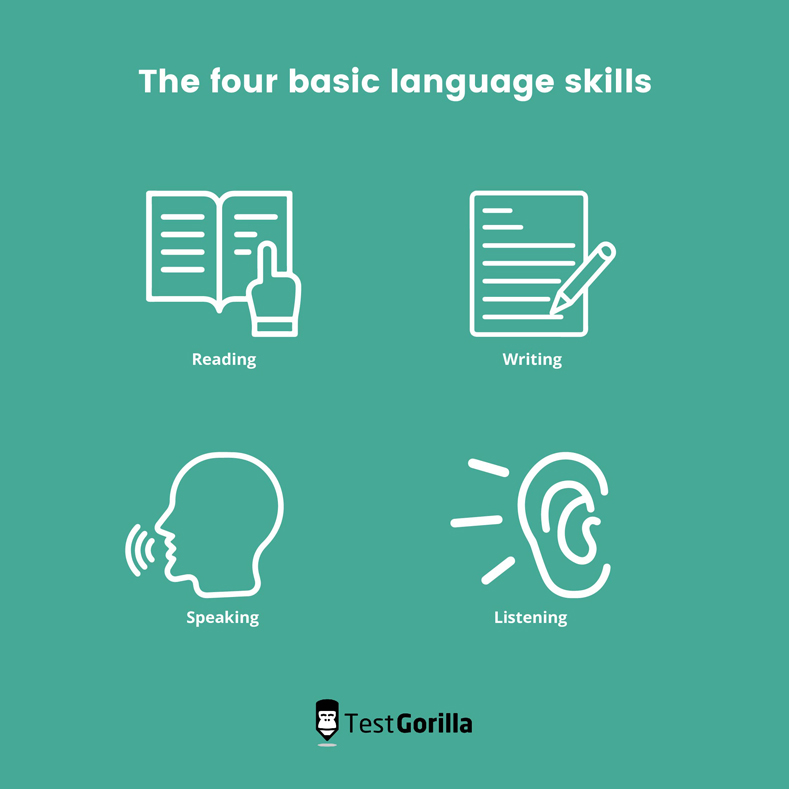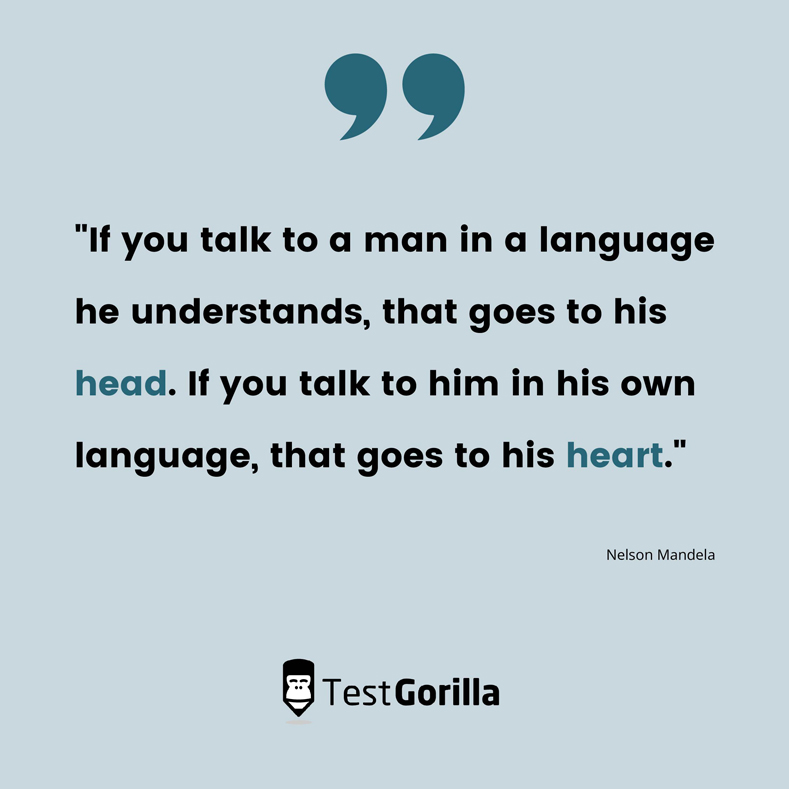As businesses become ever more globalized, many have realized the need to hire staff who speak different languages. This is especially true for localization, where brands need to take different cultural norms into consideration, and may need to change the wording of their advertising and websites if it doesn’t translate well.
Around 10.85 million people around the world speak Swedish, and it’s also one of the official languages of the European Union (EU). If you are looking to hire intermediate Swedish speakers who have more than just the Swedish language basics, you may be wondering what is the best way to evaluate their skills.
The fastest, fairest, and most accurate route to success is to have them take a Swedish language test.
We’re going to look at how you can use our Swedish (intermediate/B1) test to hire candidates with the right language skill levels, and how to combine this test with others to create a wider pre-employment skills assessment.
Table of contents
The different language proficiency levels in CEFR
If you’re not familiar with language proficiency levels, you may be wondering what intermediate/B1 means, and who has decided on these levels.
The Common European Framework of Reference (CEFR) for languages decided to build a simple-to-understand, standardized framework for language proficiency. It’s frequently used by employers in job advertisements to ensure they find staff with the right level of language competence.
The CEFR framework consists of six levels from A1 (beginner) through to C2 (fluent/native speaker level), with each stage representing improved understanding of and fluency in the language.
B1 level Swedish is considered intermediate, but not expert. This means that B1-level Swedish speakers can communicate at work and socially, but may struggle to understand more complex or unfamiliar topics**.**
At this level, students are beyond the basics but they are still not able to work or study exclusively in Swedish. At the B1 level, students should have a working vocabulary of about 2500 words, and they can recall around half of those quickly and without thinking about it.
B1-level Swedish speakers can:
Describe experiences and future plans
Listen to and understand Swedish TV shows, but will still need subtitles on.
Understand what’s going on in the Swedish news.
Write simple texts on topics that are familiar or of interest to them
B1-level Swedish speakers can successfully work in entry-level roles such as hospitality, bar, retail, warehouses, or factories. They may have difficulty working in more communication-heavy jobs though, like customer service, content writing, sales, or in management positions.
If you want to hire staff who have more than the Swedish language basics, our C1 level Swedish language test may suit your needs better.
Next, we’ll look at the building blocks of language skills, and give you ideas on how to assess each category.
Basic language skills and how to assess them
You need to evaluate all four skills in order to find staff with the right level of Swedish language ability. Let’s take a closer look at these skills.
1. Reading
Most jobs require the reading of written material in some form, whether that’s simple instructions and emails, or more complicated reports and presentations.
You need to find out what level of Swedish reading comprehension your candidates have, and you can easily evaluate reading skills and overall fluency by using a Swedish language proficiency test as part of your hiring process.
TestGorilla’s B1 Swedish test uses a variety of texts written in Swedish to assess candidates’ reading skills.
2. Writing
Those who work in entry-level roles may not need more than B1-level Swedish writing skills, but other jobs that involve a lot of writing or text-based communication require excellent written Swedish. You should evaluate how well candidates can communicate their thoughts in Swedish text.
Our Swedish language proficiency test puts candidates through their paces in grammar, vocabulary, and sentence composition, but you can also customize our B1 Swedish language test to suit your needs.
For example, you can ask candidates to provide a written answer to a question you created. This can be a useful addition to the test questions to further assess their writing skills in Swedish.
3. Speaking
Job roles at all levels require some form of speaking to other people. Employees must be able to communicate and discuss important verbal information, either in person, on the phone, or by video call.
You need to know how well your candidates can talk with other Swedish speakers. One good way is to create a custom video question as an addition to our Swedish language test and ask the applicants to record their answers in Swedish.
You may also decide to conduct short phone or video interviews in Swedish as a way to screen candidates. However, if you are not a proficient Swedish speaker yourself, you will need to find an expert Swedish speaker to conduct the interviews and help evaluate the applicants.
4. Listening
If an employee can’t understand spoken Swedish well enough, it could lead to misunderstandings and mistakes. This makes it crucial to assess applicants on their listening skills.
Our Swedish language test includes having the candidates listen to a recording in Swedish and answer the associated question. As above, you could also conduct brief interviews in Swedish to assess their listening skills.
How to use the B1 Swedish language test
A language proficiency test is a test that enables you to discover how skilled an applicant is in a specific language.
The average cost per hire is $4,425 in the US, and using traditional hiring practices to assess language skills (such as the CV or resume) risks wasting money if it doesn’t work out well. Language proficiency tests like our B1 Swedish language test are far more accurate and can cut hiring costs and time.
Recruiters and organizations can use our language proficiency tests to make it easier to assess candidates’ language skills or to test existing employees’ language abilities if you are looking to hire internally.
When you use our Swedish language test at the start of your recruitment process, you get accurate, data-driven results that you can use to draw up your interview shortlist.
Those who score highly on our B1 level Swedish language test can speak the Swedish language at an intermediate level. This means they can communicate with customers, colleagues, and others comfortably in the familiar day-to-day situations that can arise in the workplace.
The texts and sentences used in our B1 Swedish language test mimic real-life situations at work and in everyday life. Top scorers on this test will be able to understand simple, connected sentences on topics that they are knowledgeable about.
You may decide to use the Swedish language test as a standalone test, or even for existing employees. However, we recommend using it as part of a pre-employment skills assessment for the best results if you are actively recruiting candidates.
Build an assessment around the B1 Swedish language test
An employee’s Swedish language skills are only a small part of the role you are hiring them for.
They will need other job-related technical and soft skills too, so we’ve made it easy for you to test for all of these skills at once with our assessments.
How does an assessment work?
TestGorilla assessments consist of up to five separate tests chosen by you, which the candidates take in one sitting.
For example, if you chose to use the B1 Swedish language test as part of your assessment, you could add up to four other tests related to the job role you are hiring for.
These could be any combination of our tests, including:
As a quick example, say you are hiring hospitality and restaurant staff who need to have a B1 level of Swedish.
The first test you would choose to add to an assessment would be the B1 Swedish language test, and then perhaps the Hospitality (Hotel incl. Restaurant) test. Next, you may decide to test candidates’ ability to think fast and work out issues with our Problem-Solving test, and perhaps add our Time Management test or Big 5 (OCEAN) personality test.
This gives you a well-rounded assessment of skills relevant to hospitality and restaurant staff, along with a Swedish language evaluation.
It’s quick and simple to set up an assessment, but if you want more information you can find it all in our comprehensive guide to creating and editing an assessment.
Hire your next B1-level Swedish speaker fast with TestGorilla
We know it can be difficult and time-consuming to find Swedish speakers with the right level of proficiency in the language, but our tests and assessments are designed to make the process quick, fair, and accurate.
Hopefully, this article has given you food for thought and has inspired you to look into skills testing as a modern alternative to the CV.
Sign up for your free plan now to get started on building your first assessment. There’s no time limit on this plan – it’s free forever, and is a great way to get started with TestGorilla.
If you want more information or to see how our products work first-hand, book a free 30-minute live demo with our sales team, who will be pleased to answer any questions you may have. If you’re ready to dive right in, head over to our pricing page and check out our range of plans to suit all businesses.
Related posts
Hire the best candidates with TestGorilla.
Create pre-employment assessments in minutes to screen candidates, save time, and hire the best talent.
Latest posts
The best advice in pre-employment testing, in your inbox.
No spam. Unsubscribe at any time.

Hire the best. No bias. No stress.
Our screening tests identify the best candidates and make your hiring decisions faster, easier, and bias-free.
Free resources
Anti-cheating checklist
This checklist covers key features you should look for when choosing a skills testing platform
Onboarding checklist
This resource will help you develop an onboarding checklist for new hires.
How to find candidates with strong attention to detail
How to assess your candidates' attention to detail.
How to get HR certified
Learn how to get human resources certified through HRCI or SHRM.
Improve quality of hire
Learn how you can improve the level of talent at your company.
Case study: How CapitalT reduces hiring bias
Learn how CapitalT reduced hiring bias with online skills assessments.
Resume screening guide
Learn how to make the resume process more efficient and more effective.
Important recruitment metrics
Improve your hiring strategy with these 7 critical recruitment metrics.
Case study: How Sukhi reduces shortlisting time
Learn how Sukhi decreased time spent reviewing resumes by 83%!
12 pre-employment testing hacks
Hire more efficiently with these hacks that 99% of recruiters aren't using.
The benefits of diversity
Make a business case for diversity and inclusion initiatives with this data.


























